One of the first things a spectator will notice at any track and field meet is the seemingly endless array of colors on the athletes’ feet. Look at any given pair of feet, and you will see a unique pair of shoes — some green, some yellow, some blue, some orange.
The rainbow of colors isn’t the only thing that makes this footwear stand out; each shoe is designed for a different event on the track or in the field.
For example, sprinters race in a shoe with a stiffer sole to keep them on the balls of their feet, while middle-distance and distance runners wear a more flexible shoe with padding in the sole. Long-jumpers and triple-jumpers compete in a shoe similar to those of sprinters but with more support. High-jumpers wear a shoe with metal spikes in the heel to gain traction when pivoting in their approach.
Perhaps one of the most interesting shoe designs is the one that discus, shot put, and hammer throwers wear. The shoe does not have spikes, as the footwear for other events do, but instead a very slick bottom.
“You wouldn’t want to wear them on concrete walking downtown on a rainy day,” Iowa equipment manager Kevin Foor said.
The shoe is so distinct because those events involve throwing from a concrete ring. The lack of traction helps the throwing motion go smoother than it would with a shoe with more grip.
However, some throwers, such as senior Rachel Curry, prefer footwear with a bit more traction. Because her distinct throwing motion requires her to push off the concrete, grip is advantageous.
“Sometimes, you have to push off a bit,” the discus and shot-put thrower said. “So it helps me work with [differences in] other surfaces.”
For junior hammer thrower Jasmine Simpson, the amount of traction on the shoe is not as important as performing in a shoe that is comfortable and broken in.
“I’ve had these ones for so long that they’re kind of a halfway in between,” she said about her shoes. “I like where these have gotten, that halfway, Arnold Palmer of shoe,” referring to the half iced tea, half lemonade drink named after the famous golfer.
Foor, who handles equipment for the track teams, said the Iowa Athletics Department supplies two pairs of spikes and three pairs of sneakers to an average sprinter, along with a pair of racing flats — a lightweight shoe used for training in practice. However, he says that number can vary based on use and the number of events in which an athlete competes.
The colorful and unique apparel are the most “important piece of equipment the track athletes can have,” Foor said. Assistant coach Clive Roberts said part of the beauty of track and field is the minimal amount of equipment needed to compete.
“You don’t need too much,” the fifth-year coach said. “You really just need to have some shoes and have some willingness and desire to want to be better than you were the day before.”






